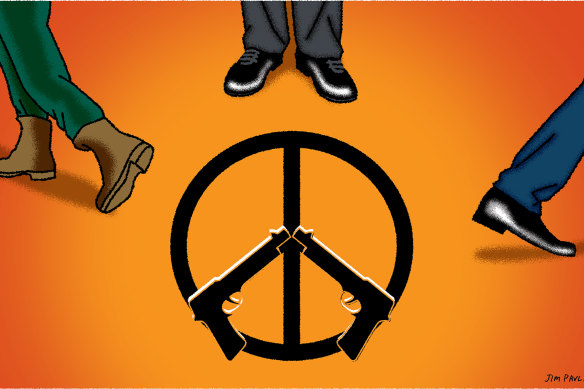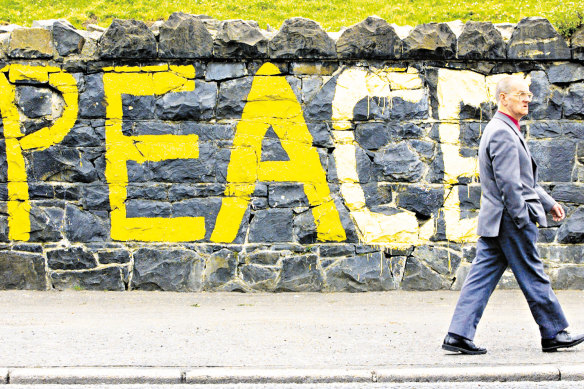This was published 1 year ago
Opinion
Northern Ireland found a path to peace. Are there lessons for Israel/Hamas?
Ray Bassett
Former ambassadorIn early 1993, and against continued conflict in Northern Ireland, a series of clandestine meetings took place in a private house in Derry, the region’s second city. These encounters involved representatives of the British Security Services (MI5/MI6) and senior figures in the IRA.

Illustration by Jim PavlidisCredit:
At those face-to-face meetings, organised by three local individuals, the position of each side was explored and the prospects of establishing a pathway to a settlement were assessed, away from the glare of publicity. It was the start of what was to become one of the world’s most successful peace processes. Those meetings were the catalyst for the events that led to the Good Friday Agreement five years later.
The meetings occurred at a time of heightened conflict, as well as the memorable comment in Westminster by then British prime minister John Major that “it would turn his stomach” to speak to the IRA. Yet when this back channel was exposed in the media, the reaction was different from what could be expected. The British cabinet minister responsible, Patrick Mayhew, offered his resignation, but it was soon realised that his sanctioning these meetings received widespread approval and even some plaudits from the opposition benches.
The British public strongly supported and appreciated his efforts at securing peace. The obvious lesson is that peace can only come when political figures are prepared to take risks, and that the public will often understand. Is there anything here that could be read across to the current Gaza/Israeli conflict?

Then Irish prime minister Bertie Ahern, US senator George Mitchell and British prime minister Tony Blair pose after signing the Good Friday Agreement for peace in Northern Ireland in 1998.Credit: AP
It is very difficult for democratic governments to admit they are in dialogue with groups that mainstream society would classify as terrorists. But there is also an onus on government to understand the forces that motivate such movements and to ascertain what will bring their activities to an end. Unless there is some form of communication, there is no pathway to a settlement. Hence, a dilemma, and governments usually opt for deniable interactions involving non-state intermediaries and/or their own intelligence services. The current hostilities in Gaza are following that pattern.
So, can the experiences gained in the Northern Ireland peace process be used in resolving other conflicts, including the one in Gaza? The first lesson is that all conflicts are different; each has its own origins, its own complications, and will need its own unique resolution. However, the resolution of a longstanding and apparently intractable dispute in Northern Ireland can give hope in other areas.
The common thread in most successful peace settlements is the presence of strong political leadership. The biggest impediment to resolution in most disputes is the absence of trust between the warring parties. It takes a strong leader to bring the doubters on his/her own side along with the necessary compromises. As the late former South African president F.W. de Klerk stated repeatedly, the toughest discussions are not with your adversary across the table but with your own side. It is in your own private room where a credible position must be arrived at, but it is also critical not to split your own delegation. I think every party to the Good Friday Agreement negotiations would re-echo de Klerk’s observations.

A man passes a peace message in May 1998 on the day of a referendum to approve the Good Friday Agreement. Credit: Reuters
Any agreement needs to be fair and balanced. As one of the main negotiators at the Good Friday Agreement put it, colourfully: “You have to let the other person get up from the table with their trousers on”. Essentially, he realised that your opponent will be your valuable ally after the negotiations, and they need to be able to sell any deal to their own constituents. Drive too hard a bargain and any peace settlement will not last.
A basic rule in the Northern Ireland discussions was that nothing was agreed until everything was agreed. This allowed parties to advance compromises, without the other side simply pocketing them. Also, all parties agreed that no atrocity outside the talks would be allowed to derail them, provided none of the negotiating organisations were involved. We were determined not to give rejectionist elements the right to destroy the process.
A key ingredient in the Irish peace process was that the talks were fully inclusive, and no major group with popular support was excluded. This included the political party associated with the IRA and, indeed, loyalist parties associated with pro-British paramilitaries. This was a very difficult situation for some of the other participants, but one side cannot select who should represent their opponent. Any agreement with an unrepresentative group is unlikely to persist.
The American government also played a pivotal role in the Good Friday Agreement negotiations, and the presence of an independent chair, who never intervened in the substance of the discussions, was an important element. It was like the role of a referee: to ensure procedures were followed but not to make judgments. Whether an American chair would be acceptable to both sides in the current Gaza dispute is a moot point, but the lesson of what occurred in Northern Ireland shows a neutral chairperson can be a huge asset for arriving at a settlement.
Once a talks process begins and delegations meet, not just across tables but also in restaurants, bars, corridors – and even toilets – informal conversations can take place. It is in these informal exchanges that the main elements of an agreement can emerge. The final formal drafting of a text is just putting down on paper what has been decided elsewhere and is often the last element in reaching a settlement.
What’s the key message? Get the talking and meeting processes under way and keep at it. Never be afraid to engage: peace is made with your enemies, not your friends.
Dr Ray Bassett is a former Irish ambassador to Canada. He was part of the Irish government’s delegation to the Good Friday Agreement negotiations.